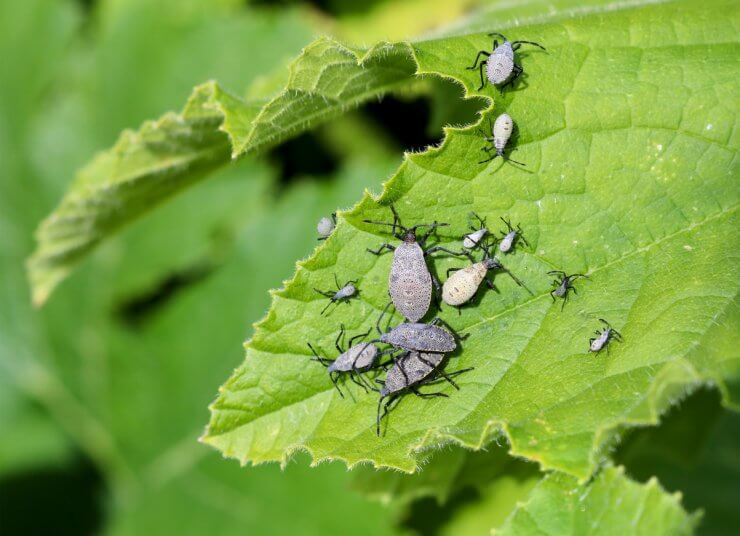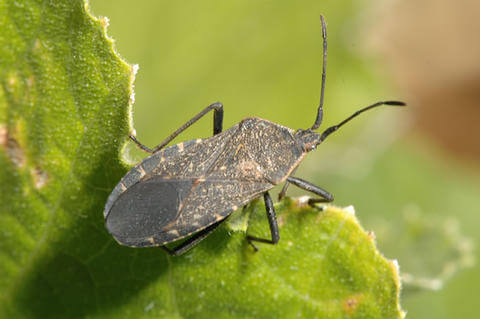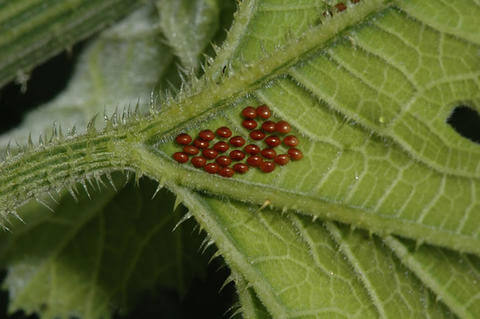
First you notice yellow or brown spots on the leaves of your squash and zucchini plants. Then the plant begins to wilt. Your established plants begin to lose runners. Younger plants die. It must be the arch nemesis of cucurbits: the squash bug.
When it comes to these garden pests, your best bet is to prevent squash bugs in the first place. Once established, they can be difficult to control as they have few natural predators. The tachinid fly and parasitic wasps will both prey on squash bugs, but thanks to a “noxious odor” the bug releases when attacked, even those have a limited impact on controlling squash bug populations.
Discover 7 top tips for growing, harvesting, and enjoying tomatoes from your home garden—when you access the FREE guide The Best Way to Grow Tomatoes, right now!

Adult squash bug.
Image courtesy of University of Minnesota Extension.
Squash bug biology
From early to late spring (earlier in warmer climates and later in cooler regions), the squash bug emerges from its winter hideout and flies to cucurbit crops such as zucchini, summer squash, and pumpkins. Once there, they feed, mate, and lay eggs on the underside of leaves. The Extension program at Utah State University points out that a female squash bug may lay up to 250 eggs over several weeks. These eggs hatch about 10 days later.
In warmer regions, you may get two generations of squash bugs in a season, but in most areas, one generation is more common. As winter rolls around, adult squash bugs will shelter in plant debris, wood piles, compost piles, and field borders.

Squash bug eggs.
Image courtesy of University of Minnesota Extension.
5 ways to prevent squash bugs from hiding out in your garden
The key to your efforts to prevent squash bugs is to keep them from overwintering. However, those efforts can begin as early as spring.
1. Row covers. Since we know that squash bugs emerge in spring and fly to feeding sites, one way to interrupt the cycle is to use floating row covers, so they don’t have anywhere to take up residence and feed or lay eggs. You’ll need to remove the row covers once the plants begin to flower, as you do want pollinators like bees and butterflies to reach them. By that time, however, your squash bugs may have moved on. (I like these row covers.)
2. Trap crops. Another way to prevent squash bugs from completing their generational cycle is to plant trap crops. The University of Massachusetts Center for Agriculture, Food, and the Environment reports that early plantings of Yellow Straightneck and Crookneck squash, as well as Blue Hubbard squash, are particularly effective trap crops. Once the squash bugs have laid their eggs, destroy the trap crop and interrupt the cycle of squash bug generations.
3. Skip the mulch. I admit it feels a little strange to write that, especially considering how much we promote mulch. However, given that we’re trying to prevent squash bugs from overwintering, taking away their habitat is one very effective way to do it.
4. Diatomaceous earth. It’s organic and effective against pests like slugs and snails, so why not squash bugs? I can’t vouch for this one, but Colorado State University Extension recommends diatomaceous earth around the base of your plants as a way to prevent squash bugs, so I imagine it’s worth a try. (I try to stick with Food Grade Diatomaceous Earth.)
5. Remove crops immediately after harvest. This goes back to the idea of removing the habitat as a way to prevent squash bugs. As soon as you harvest your crops, clean up the area, so the bugs don’t have a place to hide and overwinter.
There are other methods, as well. For example, crop rotation can work to remove the squash bugs’ food source, but that only works in large gardens where there’s plenty of room to spread out. For most of us with backyard gardens, crop rotation does have benefits, but not so much for preventing pests.
You can also use Neem oil sprays, but in order for it to work, you have to spray early on, before the squash bugs emerge from their eggs and in the nymph stage. Adult squash bugs are resistant to many pesticides.
Another option is to use a trellis and train your squash vines so they’re elevated. This won’t prevent squash bugs per se, but it will make it easier for you to spot eggs.
How have you dealt with squash bugs in your garden? I’d love to read your story in the comments.
Note: Food Gardening Network contains links to affiliate websites, including Amazon and Rakuten Affiliate Network, and we may receive a commission for any eligible purchases made by you through links on this page. Any reviews are based on honest reviews of the products.
Discover 7 top tips for growing, harvesting, and enjoying tomatoes from your home garden—when you access the FREE guide The Best Way to Grow Tomatoes, right now!





I live in Nebraska and while attending a gardening class the subject of squash bugs came up. I like the winter squashes like butternut and acorn but had quit planting them because of the squash bugs. One of the attendees said they wait to plant their squash around mid-June after the squash bug season, and then find a shorter season version of the winter squashes you desire. I gave this a try and never had any issues with squash bugs.
I keep a bucket of water in my garden to drown the adult squash bugs. They don’t release that oder that does attract other squash bugs. I also squash the eggs and then spray a soapy mixture on the leaves. I do this about every 10 days and have less each time.
Squash bugs don’t like to be wet. They tend to climb up the stims to the leaves when they get wet. They can be easily picked off and killed as they climb up to dry off.
Chickens in the all-done-fruiting gardens help keep bugs in general from returning. The diversity is also great for them!
Plant mint among your vines, they hate it.
They do pierce the vines and suck out the juices. This is why the plants die.
We have millions of squash bugs. I don’ t think I could keep on top of squashing the eggs. We used DE by spreading in with the dirt mixture but that didn’t work. I will try again. It’s like I am fighting a small battle and I am losing so far.
Dawn or generic dawn will kill the bug when sprayed directly on them in a matter of seconds. I kept on them for a few days and they were destroyed. Spray or smush the eggs too. It saved all I had left and some plants recovered.
I’ve given up planting squash. I haven’t even seen the eggs. Somehow the bugs got into our crop the first year we planted all our new gardens. We use 4, 4×8 elevated gardens built with rough cedar. They just bore into the vine stems and destroy the plant. I’ve seen a few bugs, but I leave them no protection for wintering over. I don’t use mulch at all. In the heat of the summer, I cover with 50% shade. They attack the watermelons, cantaloupe, any vine similar to the squash. I thought I had read somewhere that they are like grubs laying their eggs in the soil and then maturing in the spring. Is this not correct? I’ll try some next spring and keep any eye out for the eggs. I don’t mind squashing them to smithereens if I can find them on the leaves, but once they have bored into the vine it seems like it is too late. Is this boring into the stems what the rest of you are experiencing? Maybe I’m plagued with something other than squash bores.
You might be referring to squash borer which bore into the stems and kill the plant from within. These are different from the squash bugs in the photo above which lay eggs in clusters on the underside of leaves. These bugs eat the leaves, (and sometimes the fruit). I sprinkle diatomaceous earth on the stems early on, and it seems to help but I have to do it again after a heavy rain. I did get a few borers last summer but not like I used to. I also pick off eggs and use d.e. on leaves as well. A lot few squash bugs that way. I squash the bugs along with the eggs whenever I see them.
We’ve managed to keep the squash bugs under control by squishing the eggs. We routinely check the underside of the leaves and smash any eggs. It’s a little work, but has done a good job. Each year we seem to get fewer and fewer adults. Another method to trap the adults is to put a piece of wood next to the plant and check it in the morning. I’ll find the adults under it and squish them.
3. Skip the mulch. ……I saw lots of proof this spring for this. I’d put it at the top of the things to trip. I the DE option…..never thought of it unfortunately.